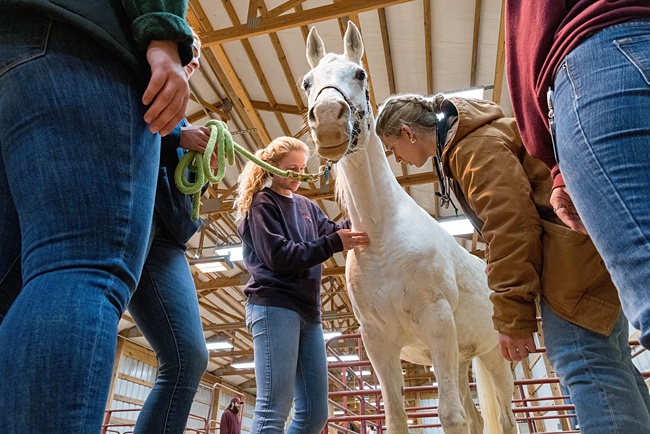Integrating ancient art and modern science: Acupuncture in veterinary education
November 30, 2023

For thousands of years, acupuncture has played a crucial role in traditional Chinese medicine, known for promoting healing and balance. Today, this practice is gaining recognition in veterinary medicine as a safe, effective complementary therapy.
The Virginia-Maryland College of Veterinary Medicine embraces this integration, combining ancient acupuncture methods with contemporary medical approaches in animal healthcare. Acupuncture is available in its Veterinary Teaching Hospital as a service and is taught to veterinary students.
This was recently underlined through hands-on experiential learning in clinical labs focusing on equine and small-animal acupuncture. Students and faculty also attended a weekend workshop, "Introduction of Acupuncture – from Anatomy to Practice," led by Wuren Ma, an associate professor at the College of Veterinary Medicine, Northwest A&F University, a national public university in Xianyang, China.
What is Veterinary Acupuncture?
Veterinary acupuncture involves placing thin needles into “acupoints” on the animal's body to stimulate the nervous system. Rather than being painful, this stimulation helps the body heal by promoting the release of natural pain-relieving substances, increasing blood circulation, and reducing inflammation.
According to traditional Chinese medicine, these acupoints are located along meridians, which are pathways through which energy, or "chi," flows in the body. By inserting needles into these acupoints, acupuncture can help restore energy balance and promote healing.
The exact mechanisms by which acupuncture works are still being studied, but researchers believe it stimulates the nervous system, releases endorphins, and modulates the production of neurotransmitters in pain perception.
Expanding horizons in animal health
Rebecca Funk, clinical associate professor in the Department of Large Animal Clinical Sciences, emphasized the importance of acupuncture.
"Integrating acupuncture is about expanding our horizons in animal health,” Funk said. “We're not just treating ailments; we're nurturing the whole being of these animals. Acupuncture's role in pain management, rehabilitation, and chronic condition treatment is indispensable in our ever-evolving field."
Elective labs during the fall semester provided third-year students with an invaluable opportunity to learn more about and apply acupuncture techniques under the guidance of faculty.
The enthusiasm among the students was unmistakable as they carefully moved their fingertips along the spines of their horses to locate the acupoints and then place needles.
"The synergy of Eastern and Western medicine is fascinating.,” said Cecelia Ivey, Class of 2025 and an aspiring equine practitioner. “I'm eager to incorporate acupuncture into my future practice."
In the same third-year class, Paul Rusak shared his plans: "Acquiring certification in acupuncture post-graduation will significantly enhance my veterinary toolkit."
Not all veterinarians jump on board during training. Faculty Amy Santonastaso’s personal journey from skepticism to embracing acupuncture underscores its transformative potential.
"I was initially a skeptic,” said Santonastaso, clinical assistant professor in the Department of Large Animal Clinical Sciences “However, experiencing acupuncture's effectiveness first-hand in treating my own herniated disc, which other treatments couldn't alleviate, completely changed my view.”


The global practice and reach of acupuncture
This year, students gained even further insight with Wuren Ma’s workshop that illustrated the global practice and reach of acupuncture.
Ma, an associate director at the veterinary teaching hospital at the Northwest Agriculture and Forestry University, delved into the basics of acupuncture, meridians, and techniques. After a series of lectures, students were able to work with faculty on anatomy structure and practicing needle placement.
Invited by a recent new faculty member at the college, Li-Jen Chang, clinical assistant professor of anesthesiology and pain management, Ma shared his journey from a Western medicine practitioner to an acupuncture expert.
"Initially, I practiced Western medicine for about a decade,” Ma said. “But as I started learning about traditional Chinese veterinary medicine, I realized the incredible potential of acupuncture in treating animals, especially in cases where conventional medicine offered limited solutions."
Ma's transition from Western veterinary practices to acupuncture was gradual yet profound.
"After witnessing the limitations of conventional treatments in certain cases, I started integrating acupuncture into my practice,” Ma said. “The results were remarkable, particularly in paralysis and chronic pain."
His expertise has been shaped by over 20 years of practice, blending Eastern methodologies with Western clinical techniques.
Funk is very conscious of this blend of balancing the “Eastern and Western brain” during her clinical work.
"It's about having a dual perspective,” Funk said. “We use our Western medicine training for diagnosis and treatment, but also embrace the holistic approach of Eastern medicine like acupuncture to provide well-rounded care."
Acupuncture can be a valuable addition to traditional veterinary medicine, providing safe and effective pain relief, promoting healing, and supporting the overall well-being of animals and offers a holistic approach to veterinary care.
If you believe your pet may benefit from acupuncture, consult a qualified veterinary acupuncturist to discuss your options and develop a comprehensive treatment plan tailored to your pet's needs.
















